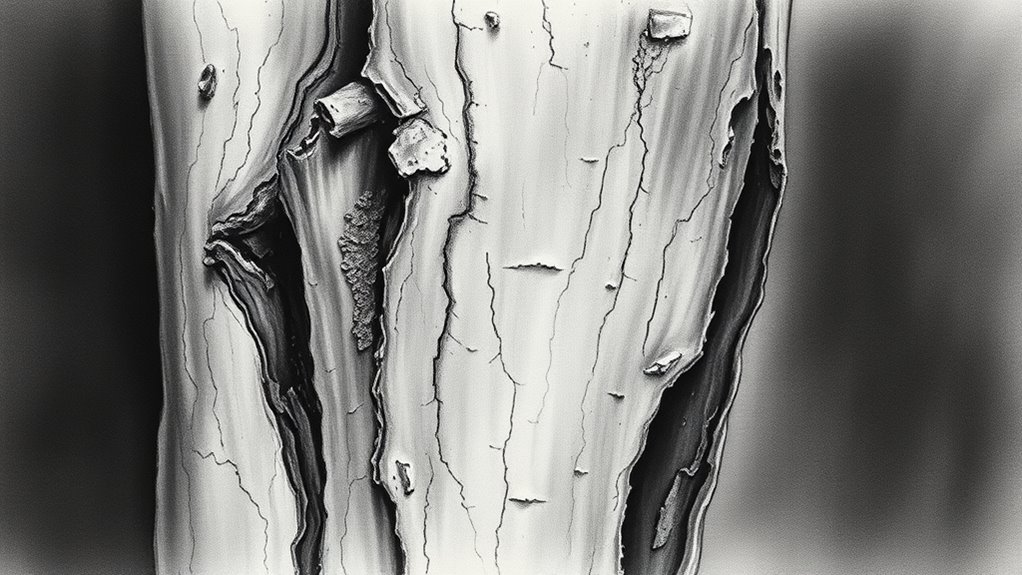To master tonal values and textures in charcoal drawing, focus on controlling pressure and layering to create a full range of shades from soft grays to deep blacks. Experiment with blending tools and erasers to refine textures and achieve seamless changeovers. Study historical techniques that emphasize experimentation for expressive effects. By practicing these methods, you’ll develop a dynamic, impactful style. Keep exploring, and you’ll uncover even more powerful ways to bring your charcoal work to life.
Key Takeaways
- Vary pressure and layering techniques to achieve a full range of tonal values in your drawing.
- Use blending tools and erasers to create seamless gradations and highlight effects.
- Experiment with different textures by manipulating charcoal on various surfaces and applying stippling or dragging.
- Study historical methods and incorporate expressive textures to enhance mood and atmosphere.
- Continually practice combining tonal control with textural manipulation for dynamic, impactful artwork.

Have you ever wondered how artists achieve striking, dramatic effects in their drawings? The secret often lies in mastering the use of charcoal, a versatile medium that allows for rich tonal variation and textured depth. To truly excel at charcoal drawing, you need to grasp the artistic techniques that harness its full potential. Understanding the historical context of charcoal art reveals that it’s one of the oldest drawing mediums, dating back thousands of years. Ancient cultures used charred sticks to create cave paintings and early sketches, which laid the groundwork for contemporary techniques. Over centuries, artists refined methods for blending, shading, and creating contrast, building a legacy of expressive possibilities. This historical background isn’t just trivia; it informs your approach, reminding you that charcoal’s power lies in its immediacy and rawness.
When you start working with charcoal, you’ll notice how different techniques influence the depth and mood of your drawing. For tonal values, the key is to control pressure and layering. Lightly sketching with the side of a charcoal stick can create soft, subtle shades, perfect for smooth transitions. Applying more pressure results in darker, more intense blacks, which are ideal for creating dramatic contrasts. To achieve a full spectrum of tones, you’ll want to experiment with blending tools like stumps, tissues, or even your fingers. This blending softens harsh lines and creates seamless gradations, adding realism and depth to your work. Conversely, using erasers strategically—such as kneaded erasers—can lift out highlights and refine textures, giving your drawing a luminous quality.
Textural effects are another essential aspect of charcoal artistry. You can create rough, gritty textures by dragging the charcoal across coarse paper or by stippling with the tip of a stick. For smoother textures, smooth blending and careful shading are your best tools. Layering different values and textures can evoke the tactile qualities of surfaces like fabric, skin, or rough stone. The ability to manipulate textures with various techniques is what makes charcoal so dynamic—allowing you to evoke mood and atmosphere in your pieces. Remember, the historical evolution of charcoal art demonstrates that experimenting with these techniques can lead to innovative expressions, from highly detailed realism to expressive, abstract forms. Additionally, understanding the legacy of charcoal can inspire more meaningful and historically informed artwork.
Mastering tonal values and textures with charcoal is about more than just technique—it’s about understanding the medium’s history and possibilities. By blending the old with your own creative vision, you can create drawings that are not only visually striking but also rich with expressive power. Whether you’re capturing a portrait’s subtle shadows or a landscape’s dramatic contrasts, these artistic techniques will help you harness charcoal’s full potential. The journey involves continual experimentation, but with each stroke, you’re contributing to a tradition that’s been evolving for millennia.
Frequently Asked Questions
What Are the Best Types of Charcoal for Detailed Work?
For detailed work, you should choose charcoal types like vine and compressed charcoal. Vine charcoal is great for light, initial sketches, while compressed charcoal offers darker, richer tones for fine details. Use blending stumps, erasers, and sharp points to refine your techniques. These charcoal types allow you to control tonal values precisely, making them ideal for intricate textures and detailed work in your drawings.
How Do I Prevent Smudging in Charcoal Drawings?
You want to prevent smudging in your charcoal drawings? Well, first, embrace your inner perfectionist with eraser techniques—use a kneaded eraser to lift off unwanted smudges. Prepare your canvas with a fixative spray to seal in your work. Keep your hand off the drawing surface, and work in sections. Remember, a little preparation and patience go a long way in keeping your masterpiece pristine.
Can I Use Color With Charcoal for Tonal Effects?
Yes, you can use color with charcoal for tonal effects by incorporating color layering and mixed media techniques. Apply light washes of colored pencils or pastels over your charcoal to add depth and mood, blending seamlessly for rich textures. Experiment with layering different media to enhance tonal variation, creating striking contrasts and vibrant effects. Just remember to keep your layers light to maintain the integrity of the charcoal’s tonal richness while integrating color creatively.
What Tools Are Essential for Blending Charcoal Effectively?
To blend charcoal effectively, you need essential tools like blending stumps, tortillons, and soft cloths. These tools help you achieve smooth tonal progressions and textures. Use gentle blending techniques to avoid smudging too much, and always keep your tools clean to maintain control and precision. Regularly clean and reshape your blending tools to make certain of consistent results. Proper tool maintenance and skilled blending techniques will elevate your charcoal drawings.
How Do I Preserve and Fix My Finished Charcoal Artwork?
Preserve your masterpiece by properly fixing mistakes and protecting highlights. You should spray a fixative lightly over your artwork to prevent smudging and keep your work vibrant. Handle it carefully, avoiding unnecessary touches, and store it in a cool, dry place. To fix mistakes, gently erase or blend with a blending stump, then reapply charcoal. These steps secure your work, safeguarding your skills and stunning textures.
Conclusion
As you lift your charcoal, remember each stroke is a whisper of your inner voice, shaping shadows and light like a silent symphony. Your mastery of tonal values and textures is the brush that paints your unique story on the canvas of patience and practice. With every drawing, you’re weaving a tapestry of depth and emotion—an enduring flame that burns brightly, illuminating your artistic journey. Keep creating; your artistry is the charcoal’s eternal dance.









